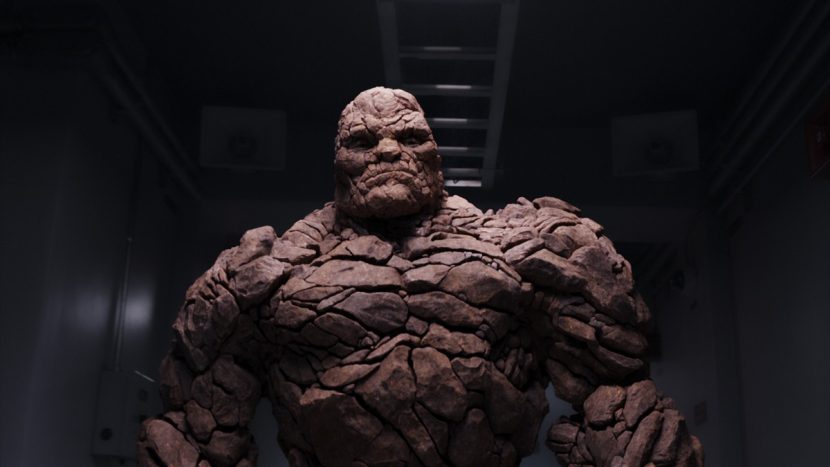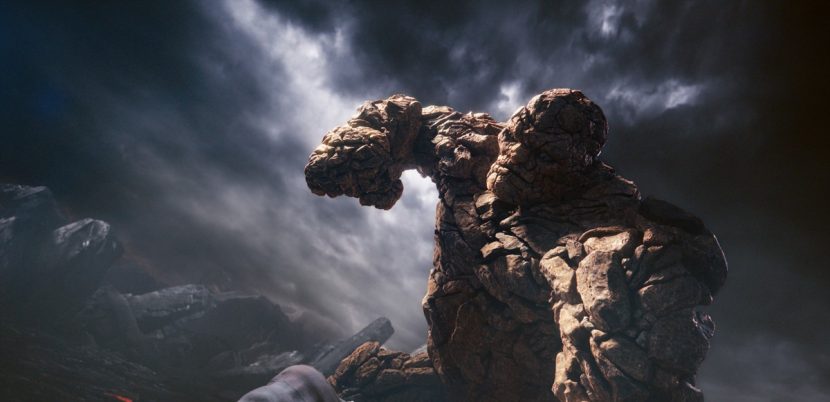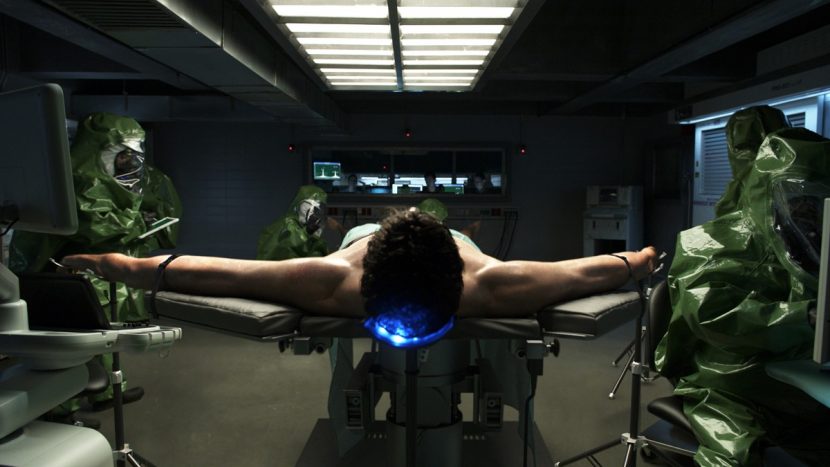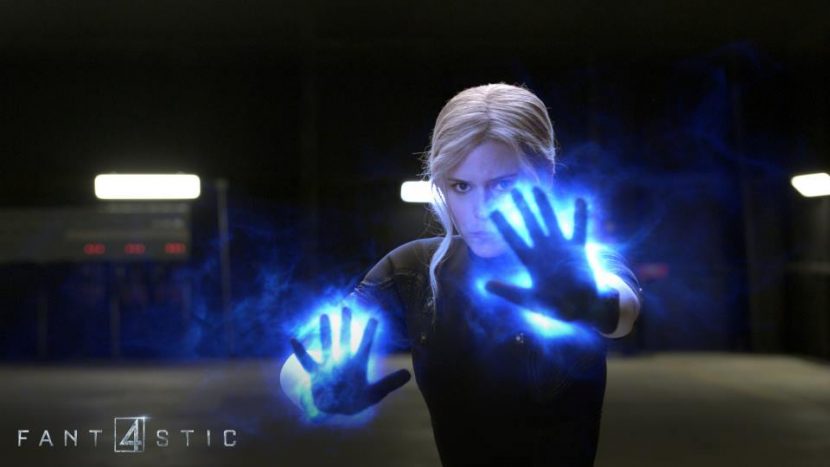The visual effects team on Joshua Trank’s Fantastic Four re-boot had several challenges – crafting views of inter-dimensional travel, making the exotic environments of an undiscovered planet and, of course, rendering the powers of the film’s main characters – The Thing, Human Torch, Mr. Fantastic, The Invisible Woman and Dr. Doom. Those powers, famous in the Marvel universe, would be brought to life under the overall guidance of visual effects supervisor James E. Price, who led principal vendors MPC, Pixomondo and Weta Digital.
The Thing rocks
 When Ben Grimm (Jamie Bell) becomes The Thing after the explosion of a Quantum Gate, audiences quickly see that the character has developed a stone body. MPC took on the effects, rendering a fully digital character based on Bell’s on-set performance.
When Ben Grimm (Jamie Bell) becomes The Thing after the explosion of a Quantum Gate, audiences quickly see that the character has developed a stone body. MPC took on the effects, rendering a fully digital character based on Bell’s on-set performance.
“The biggest challenge for Thing was with the animation and rigging,” states MPC visual effects supervisor Patrick Ledda. “There’s always a risk of making it look rubbery. With non-deforming objects like rocks, it’s quite difficult because you need the character to create certain poses and perform but you don’t want to make it look like a man in a suit.”
So MPC took The Thing on a round of R&D. “In the early stages,” recalls Ledda, “we had the idea that as a joint bends, the opposite side would reveal rocks coming out. That would mean multiple layers of rocks that reveal themselves as the rocks stretch. But it always looked a little bit noisy visually. So we ended up with a slightly different approach where the rocks are sliding on top of each other. The rocks are slightly above each other and The Thing rig allows them to slide as he stretches.”
On set, Bell wore a tracking suit and stilts to match the height and eyeline of The Thing. “We also had lots of witness cameras which helped us do roto-animation just to get the performance to match,” says Ledda. “For facial animation we did a MOVA session but we opted to just use that data for reference only, with our rigging team creating different facial poses out of that. Then for the face we used the same technique as we had with the body to slide the rocks to make facial shapes.”
Animators matched Bell’s motions, often filming themselves wearing weights to acquire reference for different walk cycles. An underlying muscle system allowed for appropriate jiggle, but not too much, since the character was intended to be made of heavy rock. “His eyes were one of the most challenging things,” notes Ledda. “Originally we tried to use his actual eyes from the plate, but the challenge was to match those with the rocks.”
The rocks themselves required extensive research. “Rocks can be very easy and very difficult at the same time because there’s an infinite detail in rock textures,” explains Ledda. “It’s almost like a fractal, so it took quite a lot of testing to come up with something that was going to work that was detailed enough and not noisy. We researched rocks, we did a ton of texture shoots with rocks. We wanted enough variation across the surface but not too much variation that it would become a pile of rocks.”
The final Thing shots were rendered in RenderMan with both procedural and hand-texturing work. “The first pass was always procedural,” says Ledda. “We came up with a nice way of generating procedural textures and baking them across all of the rocks, which would allow us to quickly change the shape of the rocks and change the topology of the rocks without having to re-texture everything every time. After the first layer, our texture artists would go in there and add detail where required or specific scratches or dents.”
Holding up the Human Torch
As his namesake suggests, the Human Torch / Johnny Storm (Michael B. Jordan), is capable of transforming into a body flames and be able to shoot fireballs and fly. MPC handled the fiery effects that Storm develops after the Gate disaster.
A couple of different looks for Human Torch were required. The first was the character turning on his ‘fire power’. Then other shots would show him engulfed in flames, while aerial viewpoints revealed him as striking fireball in the sky. Aside from the in-flight shots, most scenes had Jordan perform the sequence in the plate, sometimes with the aid of an LED suit for interactive light.
“Initially,” notes MPC’s Ledda, “the idea was to keep as much of the plate of Michael as possible and just add flames on top of the character. But that didn’t quite look like a character made of fire – it looked more like a character on fire. So we moved away from that and ended up going for a look where he goes so hot and so red that he becomes a completely incandescent surface. On one hand, from a shading point of view it was straightforward, but from a performance and integration point of view it was very complicated. The more a character is incandescent the more it loses shape. An incandescent sphere just looks like a disc, for instance. It’s very difficult to retain any shape – so how do you keep shape when the object is no longer reflecting light but is emitting light.”
Transitions from ‘fire off’ to ‘fire on’ were dealt with as relatively quick shots. “The studio was adamant that we see Michael B. Jordan performing,” says Ledda, “so we tended to make the fire come on before he delivered any lines – which meant a very short number of frames to do a transition.”
For the fully alight scenes or moments of the character beginning flight, MPC utilized a digital double of the actor acquired with scans and photogrammetry. The flames were generated in Flowline, which needed to be tweaked to art direct the final look. “We began with extremely physically accurate behavior for the fire to a very controlled behavior where the flames are completely wrapped around him,” explains Ledda.
“The hardest shots were the flying shots when he’s flying really fast, but still with the requirement to have flames all around him,” adds Ledda. “We shot some references of how flames would behave and that was definitely useful for flames, interactive light and heat distortion. We wanted the feeling that he goes so hot that he reaches supernova strength. From the beginning we also wanted to have something quite realistic in terms of dynamic range and luminance.”
Stretch-effect
The Quantum Gate explosion causes Reed Richards / Mr Fantastic (Miles Teller) to acquire the power to stretch his body, including his limbs and even facial features. Weta Digital handled the stretch effects.
A stretchy Richards is seen in several main sequences – after the initial blast, while he is recovering at Area 57, as he is confronted by The Thing in South America, and in a final battle on Planet Zero against Victor. That meant that Weta Digital had to tackle the stretching effects in different ways but always starting with the live action plate.
For shots of Richards shown recovering – but also restrained – at a secret government facility, Teller was filmed lying on a gurney with his arms and legs spread out and ducting hose tubes in place of where the elongated limbs would later be inserted.
Weta Digital’s first challenge was to come up with a look for stretched skin that looked absolutely photoreal. “What worked was to try to keep him human,” says visual effects supervisor Kevin Smith. “The second you do anything cartoony or you doing anything strange – it’s not that it doesn’t look real but your character can lose its humanity. The second his arms start to do crazy things, it’s harder to relate to him. On the gurney he’s really emotional – he’s worried about his friends – so you really want to connect to the character emotionally.”
A decision was made to have Richards stretch mostly between the joints rather than just extend the limbs in general. The result was that crucial parts of the anatomy could still be seen, such as the elbow or a bicep. The effects drew on significant work Weta Digital had done in creating believable characters from the ‘inside out’, but with some additional re-tooling for the stretching.
“We started with a Tissue rig (Weta’s physically-based character simulation framework),” explains Smith. “Believe me, we probably pushed that to way past its absolute limit. Tissue, at the end of the day, is just a big simulation. We were doing so much cheating and not volume preservation. One thing the director wanted was to see a lot of subtle muscle firings. We found that even if everything was right and you just had these big stretched out limbs, that it helped to keep them real to have little muscle firings, little twitches, to keep everything alive. Then from the Tissue rig, we used some custom tools to overlay the last 10 per cent on top of that.”
Views of the stretched out skin required Weta Digital’s traditional pipeline for dealing with sub-surface scattering, hair and detail. However, Smith suggests it was the underlying setup that gave the shots the absolute photorealism. “Even if you have all that detail [on the skin], it doesn’t help you if you’re not reading the muscles and the skin sliding over the fascia. There’s a couple of shots where you’re seeing his torso where we went in to get the extra 10 per cent by sculpting in the muscles and skin sliding.”
For some shots, Weta Digital realized Richards with the help of a digital double, while others required just body part replacements. The character’s final confrontation with Victor relied on both body replacements and carefully choreographed animation of Richards’ now more ‘spaghetti-like’ limbs. “In the battle,” says Smith, “Victor zaps him and Richards loses sense of his faculties. Miles did mime it out and we used a lot of his performance and eyelines to guide the animation and which parts are drooping. You want the audience believes he’s down for the count. How can you stretch him way way out and still maintain what we’ve been doing all along where we’re stretching him between the joints? We didn’t want him to get too bendy.”
Limbs weren’t the only parts of his body Richards is able to manipulate. While in hiding in South America, the character poses as ‘Fernando’ by altering his facial features. Weta Digital handled a morph back to his Reed Richards appearance in a single driving shot.
“They shot the Fernando actor first and then they shot Miles,” outlines Smith. “We have our digi-double for Miles and we added more face shapes that would make the topology for Reed work. We’d then match to scans of Fernando’s face. We then painted another set of color maps so we had color variation. Then we just handed off from the Fernando plate to the Miles digi-double and then slowly animated him into the real Miles. All this was done in a real car plate. We lifted the guys off, painted a clean plate for the car and put the guys back in. We kept Fernando’s body the whole time. We couldn’t morph the hair so we just did CG hair the whole way. You’re watching the shot and before you know it we’re half way there. It’s very subtle.”
The power of Sue Storm
Rocked also by the Quantum Gate explosion, Sue Storm (Kate Mara) develops the power of invisibility. She is also able to conjure up forcefields, including a helpful bubble. Pixomondo delivered these effects.
For the invisibility shots, including an initial scene of Sue lying on a gurney at Area 57, production would shoot clean and then Kate Mara plates and Pixomondo worked on the cloaking effect. “Jamie Price found great reference of an invisible cloak that some scientists had done,” recalls Pixomondo’s Sean Faden, who was aided in the studio’s work on the film by Mihaela Orzea. “The scientists had energized this material underwater and when the electricity was on, this thing that was opaque became clear. It had a refractive ripple that defined the transition. We tried to emulate that. It ended up being a combination of rendered refractive passes with traveling 3D noise generated out of Houdini. You can feel that the refraction index animates as she’s going invisible. It’s as if her body is tuning her refraction to be invisible.”
The forcefield effect relied on a Houdini sim, which also deliberately, although only partially, resembled effects that Pixomondo had created for the Baxter lab and Area 57 Quantum Gate. “Jamie really wanted to stress that all the effects were of the same family,” says Faden. “So everything had a feeling that was reminiscent of the Quantum Gate, which had given Sue her powers. In order to do that we’d start with the same noise field and then add various particle setups through the same field.”
The bubble forcefield had two looks – a normal appearance and a slightly altered version during the final battle against Doom. “It was supposed to feel like Doom’s energy was taking over the bubble and making it go a little crazy,” outlines Faden. “That started off as the same bubble setup. We introduced additional elements on top of it – so it got hotter and hotter – it needed to feel like a collapsing star around her, which Kate mimed while she acted on greenscreen against a partial set.”
Doctor Doom will see you now
Victor von Doom (Toby Kebbell) journeys to Planet Zero but falls to his apparent death; in fact, the planet’s energy subsumes him and becomes part of his own body. Pixomondo augmented the Doom costume to bring the dis-affected character to life.
During principal photography, Kebbel wore a rubber suit and mask, designed to feel like his space suit had deteriorated over time on Planet Zero. The ultimate effect was realized with a series of cracks and green, glowing energy piercing the suit. Max Riess in Pixomondo’s Frankfurt office helped art direct that look. “We played it as if the metal debris from the explosion on the planet had fused with his suit,” says Pixomondo’s Faden. “You’d have metal bits co-existing with his charred flesh that co-existed with his vinyl spacesuit. In order to sell that we went through and selectively roto’d bits on his suit that looked like it could be a metal chunk, and then we pushed the highlights, pulled it off and made it feel more like a metal suit. Anytime the rubber suit flexed too much, we would also manipulate it to make it feel more rigid.”
On top of that, effects artists added deep CG cracks. “We would render bits of the suit too to mix in on top of the plate suit,” adds Faden. “Getting it all to stick presented a lot of challenges. In NUKE we had a magnet tracker that we wrote to be able to offset and deform cracks based on multiple pattern tracks. We were able to use that to deform the cracks to stick.”
Doom’s head and neck required different solutions. The neck part of the costume was augmented to deepen the cracks and add green glows, while the eye sockets were also enhanced. “There were big holes around Toby’s eyes and you could see his black eye makeup underneath it,” says Faden. “We replaced much of it in CG. Our matchmovers had created a digital patch that represented the area between his eye area and in comp we blended those altogether. The best solution was to keep right up to the crease of the eyelids. We also changed the color of his eyes and did full iris and pupil replacement on those shots.”
Then Pixomondo added selective cracks on Doom’s head. “The smaller hairline cracks looked almost like pin pricks of light,” explains Faden. “A lot of those were generated with NUKE projection techniques using the UVs of his head.”
BONUS interview – previs by The Cavalry FX
We find out from members of the team at The Cavalry FX how they helped previs and postvis parts of Fantastic Four.
fxg: Can you give us a general overview of the previs Cavalry did for Fantastic Four?
Gavin Wright: The Cavalry was called in April 2014 at the tail end of pre-production to assist Jason Hall and FOX’s previs team with the final battle and several other sequences. Everyone was rapidly trying to get through the previs before the cameras started rolling. After principal photography ended, vfx producer Cari Thomas brought The Cavalry back on to create postvis for the editorial and vfx departments. Working closely with Josh Trank, Brian Smrz and the editorial and vfx department heads, our team created nearly 1200 temp comps and new previs shots which were used to help the editorial process and serve as timing and blocking animation for the visual effects vendors.
Matt Bauer: Cavalry was also brought in to help re-imagine several of the key action bits. Working closely with the 2nd unit Director, Brian Smrz, our team visualized the final battle, Argentina, and Area 57 sequences. Due to an accelerated reshoot schedule, we had to work extremely quick to test multiple scenarios while trying to create unique experiences for the audience and ensure the action remained clear.
fxg: Tell me about the final battle – what were the main beats that needed to be previs’d? How did you go about building character assets and the quantum bridge assets?
Matt Bauer: For the third act, we prevized everything after Doom leaves for Planet Zero. We were on a tight re-shoot schedule. Asset creation was tricky, as most new concepts hadn’t yet been visualized. It became an organic process seeing what would work both with the script, and compositionally. We were lucky to have Brian Smrz available to us on a regular basis. The ability to have him work side-by-side with us was invaluable to finishing on time.
Gavin Wright: The final battle was previs’d completely, from the destruction on earth to the mayhem of Planet Zero and ultimately to our heroes return home. There were multiple versions. The main crux of this sequence was showing that these four individuals could not defeat Doom alone, they needed to come together as a team. We had to take into account how Doom and the planet would interact and take care that he didn’t become too powerful. On top of the story aspects, we also needed to remain very conscious of the shoot schedule, the actor’s availability, the shot count and the budget. All of this was done while simultaneously creating postvis composites for every other sequence in the movie that editorial wanted help with.
fxg: How did you depict destruction for that final battle previs, since there is so much particle and destruction work?
Gavin Wright: Considering that our main function as previs/postvis artists is to make rapid prototypes of shots and sequences, our goal is to maximize our efficiency and output. So, we use as much real-time OpenGL rendering as we can get away with. While we were needed to help design the look of the destruction, we also needed to stay focused on telling the right story with each shot and be able to quickly make iterations for the editors Elliot and Steve. While that worked for much of the show, when it came to showing the massive destruction on earth and the ground and buildings being ripped away, many shots became bogged down by simulations. We worked to minimize the geometry of objects, created animated UV textures, shared caches and tried to get extremely rough blueprints of shots approved in the edit before we added in detailed animation and simulations.
Mary Manning: We paired deformers and effects systems to create the visual chaos of the living Planet Zero and the destruction that occurred on Earth. Lattice deformers were employed to wrap rocks and debris into malleable shapes while a combination of particle systems and cloth systems were applied to generate the look of the earth crumbling and tearing away. Animated textures were utilized to create the nimbus quality of the vortex storms. Through the course of developing the look of these effects, we remained ever vigilant in streamlining and optimizing the dynamic systems as to not slow down our workflow.
fxg: How did the previs for the final battle help show it might be filmed (ie bluescreen, camera angles, lenses etc)?
Matt Bauer: While previz is sometimes used to gain a general vision of sequences; in this case we made multiple passes on shots to come to a clearer blueprint for shooting. Brian leaned heavily on our team’s ability to hone in on the shots he wanted. Usually, action is filmed with longer lenses; 50mm and up. But for the final battle, we stayed on the lower end. The wider angles helped keep a sense of scale between the characters and Quantum Gate.
Gavin Wright: The Quantum Gate was absolutely huge and within the landscape of Planet Zero it was often deceiving and difficult to judge the scale and more importantly the proximity of it in the camera view. This being an entirely green screen shoot, we had to plan the action carefully to maintain accuracy while still creating compositions that would show off the amazing landscape and the Gate.
Matt Bauer: We played a lot with different ways of using each team members powers. The trickiest was Mr Fantastic; his stretching lends itself to easily looking rubbery and a little goofy. We made several different attempts of different speeds and motions to try and make him a more conditioned fighter. The goal of having their powers work together cohesively proved to be a challenge as well.
Gavin Wright: Mr Fantastic was an interesting challenge. Josh wanted to keep his powers on the edge of possibility and avoid making him cartoonishly stretch to the point of disbelief. It was decided that instead of stretching like a rubber band, his powers would allow him to stretch in a temporal space, so we played with that concept.
fxg: Can you discuss the postvis work and other techvis involved on the film?
Mary Manning: For the postvis, our team was tasked to track the live action plates and replace the green screen backgrounds with our previs assets. We strove to blend the live action and CG elements into an approximation of what the final shot would look like using additional lighting, higher render quality and compositing. These shots became the first version of the visual effects shots and were slotted into the edit to maintain the visual continuity of the movie.
Mary Manning: For the techvis, once the final battle previs was approved, our team returned to the original shots and provided the production with physical camera information. The changing values of camera height, camera tilt and distance from subject was now readily available on each shot’s reticle. This helped to inform the second unit team of the physical location of their camera within the confines of the set and was especially important when filming shots that featured the CG character The Thing. Our team also provided diagrams and overhead layouts of The Thing’s hand to hand combat sequences. This tech-vis gave a broad overview of how the CG character moved through the set and how he interacted with the live action actors.
Gavin Wright: Many of our scene files were then sent to the visual effects vendors to serve as reference or a starting point for the character and camera animation.
All images and clips copyright 2015 20th Century Fox.



